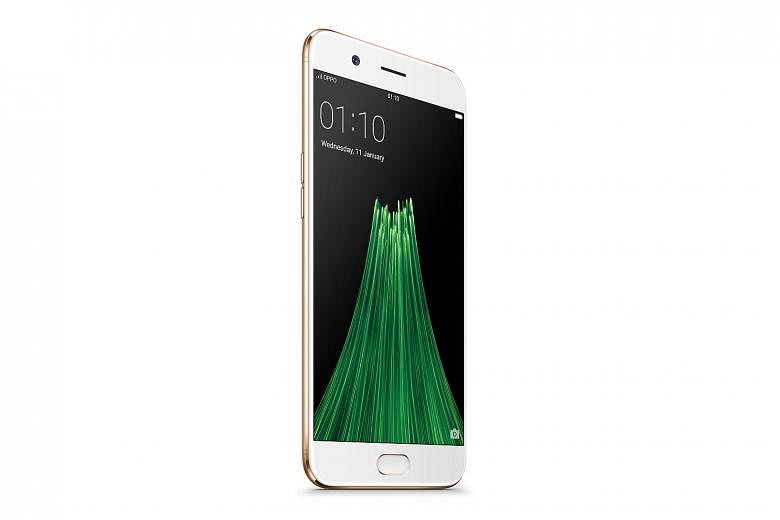Oppo's 2017 flagship R11 does not look very exciting at first glance, and it is hard to tell it apart from previous iterations of R-series smartphones. It does come with a slimmer profile and curved edges, and is made in the same metal unibody of its predecessors, such as the popular R9s.
But, in a market where phone manufacturers are trying different ways to differentiate their products - going bezel-less, toying with strange screen ratios, or adding tactile squeezes to the sides of their phones, for instance - the R11 looks positively static and unchanged.
The one area in the R11 where the Chinese company is channelling its improvements at is its unwavering obsession with smartphone photography. The result: a need to constantly bump up the megapixel count of its front camera in particular, all the better for its users' selfie needs.
The R11 takes it to the next level, with a massive 20-megapixel front camera that rivals even the rear shooters of other phones in the market.
To its credit, the R11's front camera is a beast, capable of clear, sharp selfies. Subjects are sharp, auto-focus is quick and picture quality is great when viewed on smartphones or apps like Instagram. It also comes with a whole host of camera options, such as HDR and a faux-bokeh effect, which lets you take some really outstanding selfies.
But its exposure and metering can be a bit off sometimes, as the camera tends to overexpose the background.
Its rear camera, while a decent shooter in its own right, is hurt by the lack of optical image stabilisation, resulting in low-light images that look a bit too post-processed to cover up the slight grain inherent in those photos.
-
TECH SPECS
PRICE: $699
PROCESSOR: Qualcomm Snapdragon 660 (Quad-core 2.2GHz, Quad-core 1.9GHz)
DISPLAY: 5.5-inch Amoled, Full HD, 1,920 x 1,080 pixels, 401 ppi pixel density
OPERATING SYSTEM: ColorOS V3.1 (Android 7.1)
CAMERA: 16MP, f/1.7 and 20MP, f/2.6 (rear); 20MP, f/2.0 (front)
MEMORY: 64GB (microSD expandable up to256GB), 4GB RAM
BATTERY: Non-removable 3,000mAh
RATING
FEATURES: 4/5
DESIGN: 4/5
PERFORMANCE: 4/5
BATTERY LIFE: 4/5
VALUE FOR MONEY: 4/5
OVERALL: 4/5
But the dual camera sensors at the back produce great photos in most uses, with good contrast, vivid colours and good detail.
It is a decent video shooter, too, capable of shooting 4K video which turns out remarkably smooth and clear.
For better or for worse, Oppo's phones have traditionally been compared to Apple's iPhone, such as having a similar camera bump at the back that houses its rear dual-cameras.
The R11 apes the iPhone in more than just hardware now, borrowing from iOS access to quick settings by swiping up from the bottom of the phone screen.
This is a departure from the standard Android convention of having quick settings sit on top of notifications when you swipe down from the notifications - which might throw long-term Android users off the loop.
It is a worse design tweak than Oppo's previous choice to split the notification and quick settings panels into two side-by-side ones, especially since there is little indication or instructions informing users that they can swipe up from the bottom of the screen.
The R11 performs smoothly and snappily. While its Snapdragon 660 chipset may not be the one found in premium smartphones, it is among the top tier for mid-range phones, leading to a smooth, acceptably snappy performance in the R11.
This lets the R11 process HDR shots faster, for instance, as well as letting it multitask better and more efficiently. Performance-wise, the R11 feels akin to a premium-flagship phone rather than a mid-tier one, which is befitting of its status in the Oppo product line.
It is also the only Oppo phone in the current line-up to sport the latest version of Android 7.1, although it is hindered somewhat by Oppo's own ColorOS operating system. It lacks options like split-screen multitasking, for example, which other Android users enjoy.
I was able to squeeze slightly more than a day of battery use out of the R11, which is respectable for a phone of its slimness and size.
Its quick-charging feature lets you charge it from empty to full in under two hours, or slightly over 60 per cent in 30 minutes - which suffices in most situations.
•Verdict: Oppo shows once again why it is the manufacturer of choice for those looking to buy a mid-tier phone. The R11 does not stand out much save for its strong front camera, but with solid performance across the board, it is a good option for those on a budget or not looking to splurge on a premium flagship.


